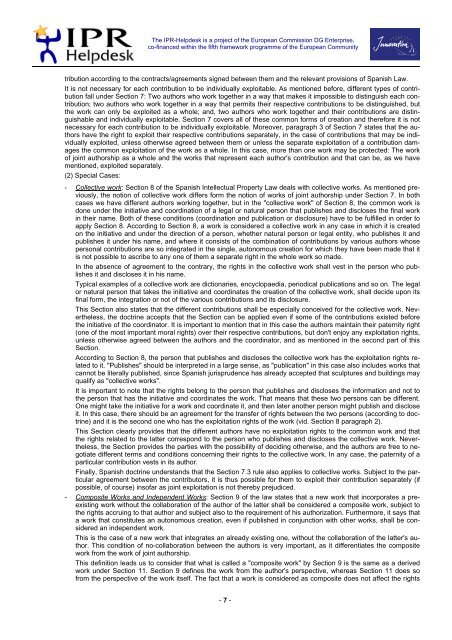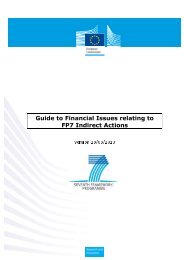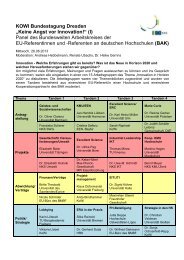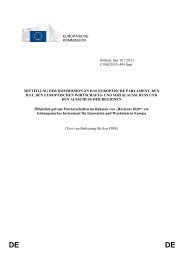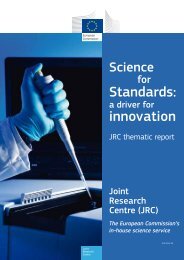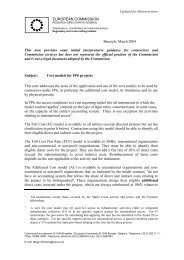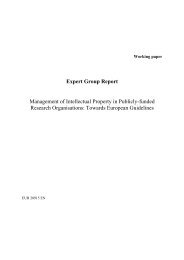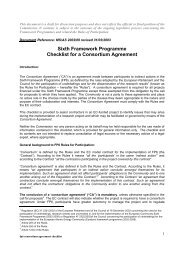Joint Ownership in Intellectual Property Rights - KoWi
Joint Ownership in Intellectual Property Rights - KoWi
Joint Ownership in Intellectual Property Rights - KoWi
Create successful ePaper yourself
Turn your PDF publications into a flip-book with our unique Google optimized e-Paper software.
The IPR-Helpdesk is a project of the European Commission DG Enterprise,<br />
co-f<strong>in</strong>anced with<strong>in</strong> the fifth framework programme of the European Community<br />
tribution accord<strong>in</strong>g to the contracts/agreements signed between them and the relevant provisions of Spanish Law.<br />
It is not necessary for each contribution to be <strong>in</strong>dividually exploitable. As mentioned before, different types of contribution<br />
fall under Section 7: Two authors who work together <strong>in</strong> a way that makes it impossible to dist<strong>in</strong>guish each contribution;<br />
two authors who work together <strong>in</strong> a way that permits their respective contributions to be dist<strong>in</strong>guished, but<br />
the work can only be exploited as a whole; and, two authors who work together and their contributions are dist<strong>in</strong>guishable<br />
and <strong>in</strong>dividually exploitable. Section 7 covers all of these common forms of creation and therefore it is not<br />
necessary for each contribution to be <strong>in</strong>dividually exploitable. Moreover, paragraph 3 of Section 7 states that the authors<br />
have the right to exploit their respective contributions separately, <strong>in</strong> the case of contributions that may be <strong>in</strong>dividually<br />
exploited, unless otherwise agreed between them or unless the separate exploitation of a contribution damages<br />
the common exploitation of the work as a whole. In this case, more than one work may be protected: The work<br />
of jo<strong>in</strong>t authorship as a whole and the works that represent each author's contribution and that can be, as we have<br />
mentioned, exploited separately.<br />
(2) Special Cases:<br />
- Collective work: Section 8 of the Spanish <strong>Intellectual</strong> <strong>Property</strong> Law deals with collective works. As mentioned previously,<br />
the notion of collective work differs form the notion of works of jo<strong>in</strong>t authorship under Section 7. In both<br />
cases we have different authors work<strong>in</strong>g together, but <strong>in</strong> the "collective work" of Section 8, the common work is<br />
done under the <strong>in</strong>itiative and coord<strong>in</strong>ation of a legal or natural person that publishes and discloses the f<strong>in</strong>al work<br />
<strong>in</strong> their name. Both of these conditions (coord<strong>in</strong>ation and publication or disclosure) have to be fulfilled <strong>in</strong> order to<br />
apply Section 8. Accord<strong>in</strong>g to Section 8, a work is considered a collective work <strong>in</strong> any case <strong>in</strong> which it is created<br />
on the <strong>in</strong>itiative and under the direction of a person, whether natural person or legal entity, who publishes it and<br />
publishes it under his name, and where it consists of the comb<strong>in</strong>ation of contributions by various authors whose<br />
personal contributions are so <strong>in</strong>tegrated <strong>in</strong> the s<strong>in</strong>gle, autonomous creation for which they have been made that it<br />
is not possible to ascribe to any one of them a separate right <strong>in</strong> the whole work so made.<br />
In the absence of agreement to the contrary, the rights <strong>in</strong> the collective work shall vest <strong>in</strong> the person who publishes<br />
it and discloses it <strong>in</strong> his name.<br />
Typical examples of a collective work are dictionaries, encyclopaedia, periodical publications and so on. The legal<br />
or natural person that takes the <strong>in</strong>itiative and coord<strong>in</strong>ates the creation of the collective work, shall decide upon its<br />
f<strong>in</strong>al form, the <strong>in</strong>tegration or not of the various contributions and its disclosure.<br />
This Section also states that the different contributions shall be especially conceived for the collective work. Nevertheless,<br />
the doctr<strong>in</strong>e accepts that the Section can be applied even if some of the contributions existed before<br />
the <strong>in</strong>itiative of the coord<strong>in</strong>ator. It is important to mention that <strong>in</strong> this case the authors ma<strong>in</strong>ta<strong>in</strong> their paternity right<br />
(one of the most important moral rights) over their respective contributions, but don't enjoy any exploitation rights,<br />
unless otherwise agreed between the authors and the coord<strong>in</strong>ator, and as mentioned <strong>in</strong> the second part of this<br />
Section.<br />
Accord<strong>in</strong>g to Section 8, the person that publishes and discloses the collective work has the exploitation rights related<br />
to it. "Publishes" should be <strong>in</strong>terpreted <strong>in</strong> a large sense, as "publication" <strong>in</strong> this case also <strong>in</strong>cludes works that<br />
cannot be literally published, s<strong>in</strong>ce Spanish jurisprudence has already accepted that sculptures and build<strong>in</strong>gs may<br />
qualify as "collective works".<br />
It is important to note that the rights belong to the person that publishes and discloses the <strong>in</strong>formation and not to<br />
the person that has the <strong>in</strong>itiative and coord<strong>in</strong>ates the work. That means that these two persons can be different.<br />
One might take the <strong>in</strong>itiative for a work and coord<strong>in</strong>ate it, and then later another person might publish and disclose<br />
it. In this case, there should be an agreement for the transfer of rights between the two persons (accord<strong>in</strong>g to doctr<strong>in</strong>e)<br />
and it is the second one who has the exploitation rights of the work (vid. Section 8 paragraph 2).<br />
This Section clearly provides that the different authors have no exploitation rights to the common work and that<br />
the rights related to the latter correspond to the person who publishes and discloses the collective work. Nevertheless,<br />
the Section provides the parties with the possibility of decid<strong>in</strong>g otherwise, and the authors are free to negotiate<br />
different terms and conditions concern<strong>in</strong>g their rights to the collective work. In any case, the paternity of a<br />
particular contribution vests <strong>in</strong> its author.<br />
F<strong>in</strong>ally, Spanish doctr<strong>in</strong>e understands that the Section 7.3 rule also applies to collective works. Subject to the particular<br />
agreement between the contributors, it is thus possible for them to exploit their contribution separately (if<br />
possible, of course) <strong>in</strong>sofar as jo<strong>in</strong>t exploitation is not thereby prejudiced.<br />
- Composite Works and Independent Works: Section 9 of the law states that a new work that <strong>in</strong>corporates a preexist<strong>in</strong>g<br />
work without the collaboration of the author of the latter shall be considered a composite work, subject to<br />
the rights accru<strong>in</strong>g to that author and subject also to the requirement of his authorization. Furthermore, it says that<br />
a work that constitutes an autonomous creation, even if published <strong>in</strong> conjunction with other works, shall be considered<br />
an <strong>in</strong>dependent work.<br />
This is the case of a new work that <strong>in</strong>tegrates an already exist<strong>in</strong>g one, without the collaboration of the latter's author.<br />
This condition of no-collaboration between the authors is very important, as it differentiates the composite<br />
work from the work of jo<strong>in</strong>t authorship.<br />
This def<strong>in</strong>ition leads us to consider that what is called a "composite work" by Section 9 is the same as a derived<br />
work under Section 11. Section 9 def<strong>in</strong>es the work from the author's perspective, whereas Section 11 does so<br />
from the perspective of the work itself. The fact that a work is considered as composite does not affect the rights<br />
- 7 -


